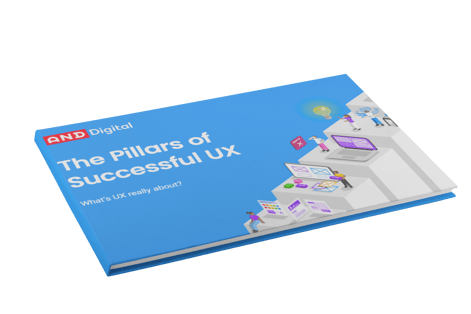User Research
Understanding New Digital Behaviours Through User Centred Design
04 July 2022 • 4 min read

The pandemic placed a premium on understanding the consumer. So in June 2022, we brought together leaders in user-centred design (UCD) to explore how to make the case for—and get the most from—UCD.
The session revealed rich insights and quick wins for UX practitioners who feel like lone advocates for UCD, for C-suite leaders who want to understand more, and for organisations that need better customer understanding to build better products. In this article, we explore the quick takeaways.
Leading the session was Rhys Billington, lead UX principal at AND Digital. He was joined by:
- Fay Djmel, Digital Psychologist, UX Research Specialist and Founder of UX Research Consultancy Human Design
- Alex Comyn, Brand Experience and Planning Principle at AND Digital’s Club Turing
- Adam Morris, Head of Product Design at The Economist
- Steve Gleadall, Global Head of Digital Product and User Experience at Costa Coffee
8 quick UCD takeaways:
1. What is UCD? What are its benefits?
Fay: UCD is an iterative design process in which multi-functional teams focus on user needs at each stage of the design process. UCD improves the functionality and user experience of digital services by placing the end user and key stakeholders at the heart of design thinking, product testing, launch and maintenance.
UCD helps achieve innovation and success at pace. it enables you to fail fast. It also ensures products are built on evidence - rather than assumption-based ideology.
2. Understanding the effect of COVID on consumers
Steve: Before the pandemic, Costa Coffee's (one of our clients) biggest consumer group was morning commuters. We placed a real emphasis on queue times and speed of service, but that has changed. Customers now want to enjoy moments with friends, so the role of UCD is to help us create digital experiences that make it easy to enjoy those moments.
3. The conscious consumer’s impact on content
Alex: As they have exited the pandemic, people have become much more considered about the type of brands they do business with. They are choosing brands that align with their own world view. That’s happening among Gen Z, but it’s also happening in the luxury sector where we are seeing more conscious choices being driven by increased awareness of impact. This is a significant moment for brands—a point at which they take a stand, as Ben & Jerry’s and Dominos have done with the UK government’s Rwandan asylum ‘solution’.
From a digital perspective, that requires a content strategy shift, thinking about the messages you want to get out and also how you talk about your products and services. That’s a clear difference from just discussing features and benefits.
4. Improved digital literacy changing the nature of users
Fay: A lower level of literacy is used to equate to a lower level of digital literacy. From the research I've been doing, that’s changing. During the pandemic, we've seen a shift in general digital capability and competence. That’s important because it influences the granularity of things like reward schemes. If more people are more comfortable with apps, you can do more with them.
5. In UCD, your people matter as much as tech
Alex: Digital is not the sole preserve of marketing. In the lifetime of a customer, everyone in an organisation could have some sort of involvement with them. To deliver a brilliant customer experience, therefore, you have to understand that experience across every department and touchpoint, physical and digital. A human interaction of just a few seconds at any point in the customer journey could have a big impact.
Your employees, therefore, become as important to UCD as the customers you're designing for.
6. Why do you need an app?
Steve: Stakeholders will often say ‘we need an app’ almost as a default. It’s important to understand the impact of that on a consumer. It takes effort to download, and if they don’t see the value in it, they’ll uninstall and not reinstall it unless you give them a very good reason to.
UCD puts you in the position of the consumer. It helps you take a leaner, more iterative approach to the knee-jerk response of ‘we need to do something’. Projects should start with the consumer, exploring how they actually use and interact with a product or service and how you are delivering against their objectives.
7. Customers expect attention
Alex: We've seen a shift away from self-serve towards call centres and live chat. People want to talk to an individual and feel that their unique needs are being listened to and that something is being done. In recent surveys, we've seen live chat become a primary interaction point with customers.
It’s an important trend for UCD.
8. To use data you need to get data
Steve: People are overwhelmed by the number of choices they have. Personalisation that gets the right product to the right person at the right time is hugely important. We use recency/frequency/value modelling which enables us to categorize consumers from brand advocates to the people who flip between Costa and other brands. By categorising them, we can put plans in place to encourage them to the next tier of engagement.
Just as important as what we do with the data, though, is getting the data in the first place. That's why the value exchange is so important. Consumers won’t give us their data unless they see value in it.
Further Reading
In our latest whitepaper, The Pillars of Successful UX, AND Digital’s UX researchers share their insights for turning powerful UX research into user-centred design that makes a difference



-1-2-1.png?width=564&height=348&name=Untitled-4-min%20(1)-1-2-1.png)
